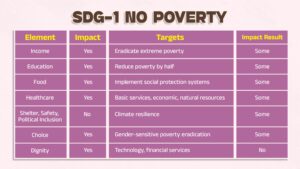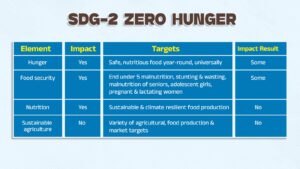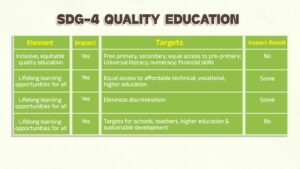Meanwhile, the study also identified gaps, delays in receiving benefits and barriers in access — administrative and technological.
Published Sep 29, 2025 | 3:24 PM ⚊ Updated Sep 29, 2025 | 3:24 PM

Members of the Congress government in Karnataka launch the Shakti Scheme on 11 July, 2023. (BMTCinfo/Facebook)
Synopsis: An independent study on the impact of the five guarantee schemes of the Congress government in Karnataka said that they had a positive impact on the Sustainable Development Goals envisioned by the United Nations. It added that it has enhanced the financial aspects of women and raised their living standards.
An independent study on the impact of the five guarantee schemes of the Congress government in Karnataka, presented to Deputy Chief Minister DK Shivakumar, said that they had a positive impact on the Sustainable Development Goals (SDGs) envisioned by the United Nations. It added that it has enhanced the financial aspects of women and raised their living standards.
The field study that covered all districts in Karnataka measured the impact of the guarantee schemes — Anna Bhagya, Gruha Lakshmi, Gruha Jyothi, Shakthi and Yuva Nidhi —on female beneficiaries from low-income households and their families.
The study was conducted state-wide, on women heads-of-households who are beneficiaries of two or more schemes. In-person field surveys were conducted in all four administrative divisions of Karnataka, across 15 districts, covering over 6000 women, from July 2024 to July 2025.
The survey was led by Tara Krishnaswamy, Independent Policy Consultant and field data was collected by Lokniti-CSDS, Bangalore University, Tumkur University and Indus Action.
 The study measured significant impact on women’s and their families’ nutrition and healthcare, women’s mobility and employment, dignity, agency and financial self-reliance.
The study measured significant impact on women’s and their families’ nutrition and healthcare, women’s mobility and employment, dignity, agency and financial self-reliance.
According to the report, Anna Bhagya and Shakti have over 90 percent penetration levels among lower-income group women, while Gruha Lakshmi and Gruha Jyoti are at about 80 percent.
“91 percent of respondents use the money received or saved from the five guarantees for purchasing food, supplementing the family diet with essentials, such as grains, pulses, vegetables, fruits, eggs and meat. 95 percent of the women stated that their family diet had improved; that their families were eating more meals and ingested better nutrition due to the benefits,” the report said.
While women receive Gruha Lakshmi money through direct bank transfer, they also save money due to the use of Shakti (75 percent saving up to ₹500 per week) and Gruha Jyoti (74 percent saving up to ₹500 per month).
“Beneficiaries experience high levels of unmet health care and medical needs, with 85 percent directing funds towards medical expenses, including doctors’ visits, hospital bills and medicines. Not surprisingly, 77 percent of loan repayments through the savings are against healthcare-related debts,” it said.
 The report said an average of 19 percent of lower-income women across the state report getting a new job or switching to a better-paying job due to zero-ticket travel.
The report said an average of 19 percent of lower-income women across the state report getting a new job or switching to a better-paying job due to zero-ticket travel.
Shakti is a tour de force for lower-income women’s employment and income boost, the authors said in a press release. In Bengaluru Urban district, 34 percent reported new or better jobs, with 26 percent having acquired new jobs.
“A significant 93 percent reported that their standing had improved within their family, a changed family dynamic. Gruha Lakshmi and Shakti, also fall under gender equalising policies, valuing unpaid care, and strengthening participation in the public sphere,” the report said.
 With Gruha Jyoti, 72 percent women reported that their families now use more lights, hence being able to cook in peace, as children do their homework. Of the respondents, 43 percent purchased new appliances like heaters, mixers and refrigerators.
With Gruha Jyoti, 72 percent women reported that their families now use more lights, hence being able to cook in peace, as children do their homework. Of the respondents, 43 percent purchased new appliances like heaters, mixers and refrigerators.
“Gruha Lakshmi and Shakt, specifically target female beneficiaries for their empowerment and independence. The combination of money at hand and free mobility has opened up opportunities and benefits for women themselves and their families. It allows them to reach healthcare facilities and spend on medicines and tests,” the report said.
“It enables better education for their children, purchase of educational materials, and access to farther away colleges and hostels. Gruha Jyoti’s free baseline electricity has improved beneficiaries’s well-being and family relationships, relieving strain from economising on domestic appliance use during peak hours,” it added.
Beneficiaries reported that they could visit their children in hostels more frequently and meet their maternal family members without having to ask their husbands to sponsor travel and expenses. Elderly women were able to visit their married children without being dependent on sponsorship, the report said.
“Women were able to travel for household purchases at markets, sightseeing, etc., together, as friends that almost 60 percent felt built their sisterhood. This new-found adult agency gave beneficiaries a dignity that 72 percent reported as boosting their self confidence and empowerment,” it added.
 Meanwhile, the study also identified gaps, delays in receiving benefits and barriers in access — administrative and technological. The report made recommendations on actions to be taken by the state government to fine-tune the policies.
Meanwhile, the study also identified gaps, delays in receiving benefits and barriers in access — administrative and technological. The report made recommendations on actions to be taken by the state government to fine-tune the policies.
For instance, Anna Bhagya enrolments have been closed for about two years as they prune spurious entries, but extremely deprived communities like PVTGs (Particularly Vulnerable Tribal Groups), waste workers, etc., have been excluded and face serious deprivation.
The majority of women heads-of-households from low-income groups, the beneficiaries, have 10th standard level education or less. They struggle to use the mobile apps, portals, ATMs, and read electricity bills. Financial and digital literacy in Panchayats will go a long way.
 “In their current design and deployment, none of the three schemes, Shakti, Yuva Nidhi, and Gruha Lakshmi, result in increases in large-scale employability, employment and economic growth. All three enable the seeking of a better or new job, and stemming economic distress, but do not present evidence of increasing economic outcomes. All three schemes have the potential to catalyse employment on scale but will need redesign.
“In their current design and deployment, none of the three schemes, Shakti, Yuva Nidhi, and Gruha Lakshmi, result in increases in large-scale employability, employment and economic growth. All three enable the seeking of a better or new job, and stemming economic distress, but do not present evidence of increasing economic outcomes. All three schemes have the potential to catalyse employment on scale but will need redesign.
The report also pointed out that implementing Shakt resulted in overcrowding of buses, inconveniencing male passengers inadvertently. “The planned induction of 5800 new buses could alleviate some of this,” it said.
“Positioning Gruha Lakshmi as financial security for women, casts it as patronage, instead of as basic income for unpaid household labour, an entitlement. This misrepresents the scheme in the eyes of some recipients themselves, making them feel ‘undeserving’,” it added.
It also added that beneficiaries perceive a paucity of bilateral communication and suboptimal channels with respect to grievance redressal and ease of use of schemes.
“Government communication under-emphasises the transformative nature of the five guarantees to the public and media. The evidence from this study, and others, could be utilised to elide the ‘freebies’ moniker and rebrand the schemes accurately, as social security and welfare policies for sustainable and equitable development,” the report said.
(Edited by Muhammed Fazil
